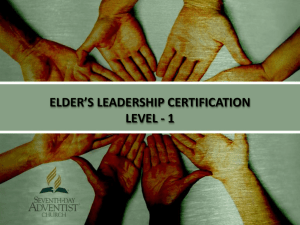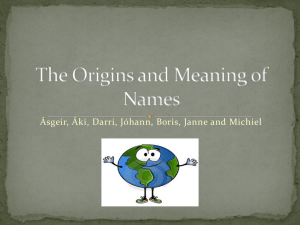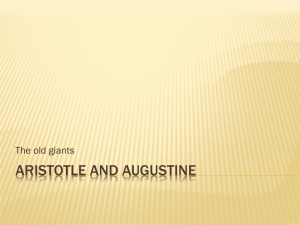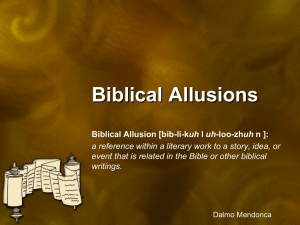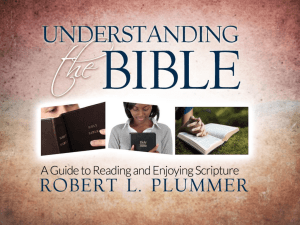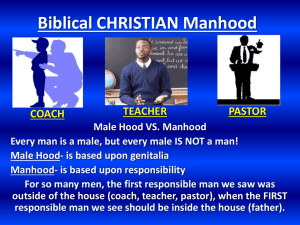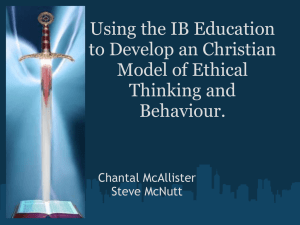Using the Visual Valet Model to Develop a Biblical Perspective
advertisement
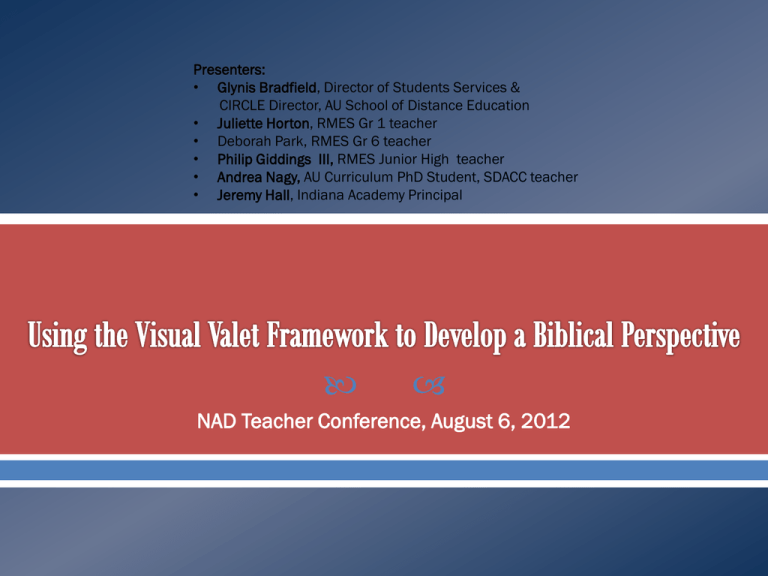
Presenters: • Glynis Bradfield, Director of Students Services & CIRCLE Director, AU School of Distance Education • Juliette Horton, RMES Gr 1 teacher • Deborah Park, RMES Gr 6 teacher • Philip Giddings III, RMES Junior High teacher • Andrea Nagy, AU Curriculum PhD Student, SDACC teacher • Jeremy Hall, Indiana Academy Principal NAD Teacher Conference, August 6, 2012 YES Seeing how the topic reveals the character or nature of o God o Creation o Mankind o Moral Order o Purpose Thinking critically about every aspect of our lives as connected to the topic NO Including a Bible verse at the top or bottom of a worksheet. Diagramming a Bible verse in grammar class. Reading one or all the Bible verses on horses after a horse unit. Using a science experiment as an analogy to the Christian life. Praying once or several times a day in class. Having class devotions. Casually referring to the greatness of God during a science lesson. Without an eternal perspective, life and all its component parts do not make sense. (p.38) Our understanding and practice of God’s truth is very limited compared to the knowledge we have accumulated. At least part of the problem is a perceived detachment of biblical truth from almost everything that is not biblical. (p.22) Biblical integration is not about finding the "right verse" or "the only“ Christian way to deal with every class and every subject. It is about fitting everything we know and teach into the very BIG picture of what God is doing. (p.22) Klassen, Visual Valet The Visual Valet framework can assist anyone in organizing and communicating the essential elements of the Christian faith, from a great controversy perspective. God made everything Sin wrecks everything Jesus fixes everything God uses everything • • • • The study of non-Biblical material should reveal reflections of God. Distortions are to be expected in everything because of the Fall. The Bible always takes precedence over what we think we’ve discovered in the world, in ourselves, in our relationships with others and with God. The Visual Valet suggests applications for all we learn, so everything will fulfill God’s ultimate intention that people live in loving relationship with Him. Framework Integration Guide Creation Reflections Fall Distortions Redemption Revelations Fulfillment Applications CREATION FALL REDEMPTION FULFILLMENT – Reflections - Distortions – Revelations – Applications What aspect of God’s character do I understand better because of ____? In what ways has ___ been distorted by the fall of man? What has God revealed in the Bible about ____, Himself & His purposes? How does ___ make me appreciate God and desire to worship Him? What was God’s original purpose for ____? In what ways has ___ been spoiled and misused? How does the Bible confirm God’s revelation in ____? How can ___ be used for God’s purposes within His family and His world? What is good, beautiful, true, valuable? What is bad, ugly, false, worthless? How do we know? How do we choose? What are the consequences? What is the purpose? 99 Questions: closethegapnow.org/resources/christianeducation/index.html The Visual Valet model can: Remind you to implement biblical integration Help you organize all God says about Himself and His creation Guide you in making the connections that are central to biblically integrated Christian thinking Help you develop critically important thinking skills in your students Help you become a distinctively Christian thinker and teacher Identify biblical principles to be integrated. Move from the big picture to the details. Plan assignments and discussion questions that cause students to begin thoughtfully considering biblical principles. Consider how biblical principles from other subject areas may be related. Allow students to apply the principles personally. Use informal opportunities, as well as more formal situations. Assess biblical integration. 1. Biblically Integrated Math Lesson Plan Juliette Horton, RMES Gr 1 Teacher, Michigan 2. Music Lessons Andrea Nagy, Gr 8 Teacher, Canada 3. Faith Integrated Physics & Literature Lessons Philip Giddings III, RMES Gr 8 Teacher, Michigan 4. Pangea and Continental Drift Theory Lesson Plans Deborah Park, RMES Gr 6 Teacher, Michigan 5. Staff Evaluation Using the Visual Valet Model Jeremy Hall, Indiana Academy Principal 6. Website Development Unit Plan Samuel Villamizar, VAES Gr 7-10, Michigan Being transformed • Unless I am continually developing a more distinctively Christian way of thinking and teaching, I cannot blame the system in which I teach for hindering me. If I am personally overflowing with new insights which fill me with gratitude and worship, my students will notice. If I choose God's ways instead of my own in all areas of life, students can learn to choose His ways also. Even if they do not understand the things of God they cannot deny He is making a difference in my life. Being transforming • I cannot change others; the Holy Spirit can, and uses us to demonstrate and articulate truth. I can teach, confident of Christ’s presence as I prepare and interact with students and colleagues. Producing transformers • I am called to disciple students and colleagues, so that what God invests in my life may be multiplied in the lives and ministry of many others. Start with personal Bible study, connecting with the Visual Valet framework. Ask the right questions in your study – related to this framework. Look for answers in the right places – in God’s Word and world. Cultivate an eternal perspective – without it all the parts of life don’t make sense. Choose to be intentional. Prepare the climate for student transformation. Work together. Ask questions that prompt students to connect what is learned at home, church, and school. Ask the right big questions e.g. use the Visual Valet framework. Encourage students to ask the questions of themselves. Deal with common distortions to remove obstacles to growth and development. Share what God has been teaching you and how He has been changing you. Clarify that spiritual things are spiritually discerned - nonChristians cannot understand God’s perspective. Pray before, during and after – continually. Expect to be learning forever – the joy of discovery requires something unknown and unexplored! Invite your students to join you in discovery learning, led by the Holy Spirit. Organize your deepening understanding using the framework, adding new questions to explore as time allows in future lessons/years. Invite colleagues to join you on the journey. Share to save time. Synergize. Ask God to lead you to intentionally teach patterns of God’s truth in every lesson. Biblical integration is not about finding the "right verse" or "the only“ Christian way to deal with every class and every subject. It is about fitting everything we know and teach into the very BIG picture of what God is doing. Klassen (2008), Visual Valet: Complete Book with User’s Guide, p.22 transformingteachers.com – Visual Valet & many stimulating and practical faith integration articles closethegapnow.org – questions to foster biblical integration and other practical faith integration assessments & other teaching tools biblicalintegration.com – lesson templates, examples & posters circle.adventist.org – faith integration sections & much more CIRCLE is the google of Adventist education, the Curriculum and Instruction Resource Center Linking Educators anytime, anywhere, as they continue the teaching ministry of Jesus Christ. Find resources created by and for Adventist educators at all levels, from all world regions – think outside your region/box. Be synergized. Join the CIRCLE. Glynis Bradfield, CIRCLE Director, glynisb@andrews.edu Director of Student Services, griggs.edu & andrews.edu/distance Growing Disciples Inventory researcher, growingfruitfuldisciples.com/gdi/


